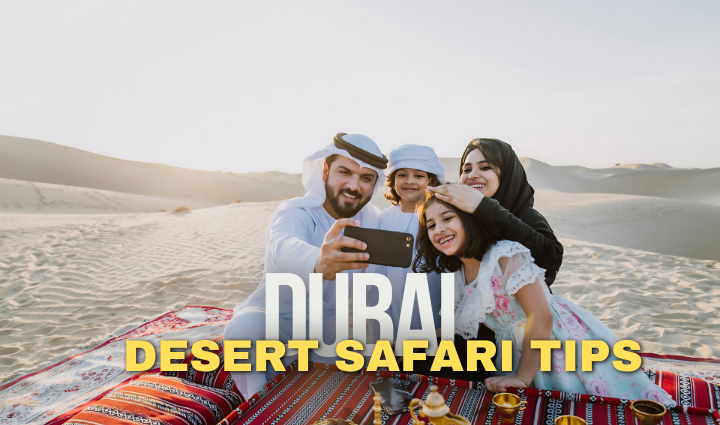Dubai Desert Safari Tips
Dubai is renowned for its modern skyscrapers, luxurious shopping malls, and vibrant nightlife, but there’s another side to this glamorous city that is equally mesmerizing—the vast and tranquil desert. A Dubai Desert Safari is an adventure that takes you away from the hustle and bustle of the city and immerses you in the serene beauty of the Arabian Desert. Whether you are a thrill-seeker or someone looking to experience the culture and traditions of the UAE, a desert safari offers something for everyone.
Planning and preparation are crucial to fully enjoying this unique experience. A desert safari is not just about hopping on a 4×4 vehicle and heading into the dunes; it involves selecting the right package, dressing appropriately, and being mindful of the desert’s harsh environment. This guide will walk you through the essential tips to ensure that your Dubai Desert Safari is both memorable and safe.
Choosing the Right Time for Your Safari
One of the first decisions you’ll need to make when planning a desert safari in Dubai is choosing the right time to go. The desert environment can be harsh, with extreme temperatures during the summer and cooler, more pleasant weather in the winter. Understanding the best time to visit will greatly enhance your experience.
Best Time of Year to Visit the Desert
The ideal time to embark on a desert safari in Dubai is during the winter months, from November to March. During this period, the weather is cooler, with daytime temperatures ranging between 20°C to 30°C (68°F to 86°F). This makes outdoor activities like dune bashing, camel riding, and sandboarding more enjoyable. The evenings can be slightly chilly, so it’s advisable to bring a light jacket or shawl.
On the other hand, the summer months, from April to October, can be extremely hot, with temperatures soaring above 40°C (104°F). While it’s still possible to go on a desert safari during the summer, the experience may not be as pleasant due to the intense heat. If you do choose to visit during this time, consider booking an evening or overnight safari to avoid the scorching midday sun.
Ideal Time of Day for a Safari: Morning vs. Evening vs. Overnight
Dubai desert safaris are typically available in three time slots: morning, evening, and overnight. Each option offers a different experience, so it’s important to choose the one that best suits your preferences.
- Morning Safari: A morning safari is perfect for those who want to enjoy the desert’s tranquility before the heat of the day sets in. Activities usually start early, around 7:00 AM, and include dune bashing, camel riding, and sandboarding. The morning safari typically lasts about 4 hours, making it a great option for those with a packed itinerary.
- Evening Safari: The evening safari is the most popular choice among tourists. It starts in the late afternoon, allowing you to experience the desert as the sun begins to set. This time of day offers breathtaking views and is ideal for photography. In addition to the standard activities, evening safaris often include cultural experiences such as henna painting, belly dancing, and a traditional BBQ dinner at a desert camp. The evening safari usually lasts about 6 to 7 hours.
- Overnight Safari: For those looking for a more immersive experience, the overnight safari is the way to go. It includes all the activities of the evening safari, plus the unique experience of spending the night in the desert. You’ll sleep in a traditional Bedouin-style tent under the starry sky, waking up to a beautiful desert sunrise. The overnight safari also provides an opportunity to enjoy stargazing, an experience that is truly magical in the desert’s clear night sky.
Weather Considerations and How They Impact Your Experience
The weather in Dubai can greatly impact your desert safari experience, so it’s essential to plan accordingly. During the winter months, the weather is generally pleasant, making it the best time for outdoor activities. However, temperatures can drop significantly at night, so it’s wise to dress in layers to stay warm.
The summer heat can be intense, especially during the day. If you plan to go on a safari during this period, it’s important to stay hydrated and wear sunscreen to protect your skin from the sun’s harmful rays. Opting for an evening or overnight safari during the summer is advisable to avoid the extreme temperatures of the midday sun.
Types of Safaris: Standard vs. Luxury vs. Private
Desert safari packages in Dubai typically fall into three categories: standard, luxury, and private. Each offers a different level of service and amenities, so it’s important to choose one that aligns with your preferences and budget.
- Standard Safari: A standard desert safari is the most basic option and is ideal for budget-conscious travelers. It typically includes activities such as dune bashing, camel riding, and sandboarding, along with a BBQ dinner and cultural entertainment. While the amenities may be simpler compared to luxury options, the experience is still enjoyable and offers a taste of the desert’s natural beauty and cultural heritage. If you’re interested in a more rugged adventure, you might also consider a Jeep Safari in Dubai, which offers an exhilarating off-road experience.
- Luxury Safari: If you’re looking for a more upscale experience, a luxury desert safari is the way to go. These packages often include premium services such as a private 4×4 vehicle, gourmet meals, and access to exclusive desert camps. You’ll also have the opportunity to indulge in additional activities such as falconry, hot air balloon rides, and spa treatments. A luxury safari offers a more personalized and comfortable experience, making it perfect for special occasions or those looking to splurge.
- Private Safari: For those seeking a more intimate experience, a private desert safari is the best option. This package allows you to enjoy the desert at your own pace, with a dedicated guide and vehicle. You can customize the itinerary to suit your interests, whether it’s spending more time on dune bashing or focusing on cultural activities. A private safari is ideal for couples, families, or small groups who want a more personalized and exclusive experience.
What to Wear and Pack for a Desert Safari
When preparing for a desert safari in Dubai, your choice of clothing and the items you pack can significantly impact your comfort and overall experience. The desert environment is unique, and dressing appropriately is essential to enjoying your adventure while staying safe from the elements.
Recommended Clothing for Comfort and Safety
The key to dressing for a desert safari is to choose lightweight, breathable fabrics that keep you cool during the day and warm in the evening. Loose-fitting clothes made from cotton or linen are ideal, as they allow your skin to breathe while providing some protection from the sun.
For men, long-sleeved shirts and trousers are recommended, as they offer protection from the sun and help prevent sand from irritating your skin. Women might prefer to wear a long dress or trousers with a loose top. It’s important to dress modestly, respecting the local culture, which generally frowns upon revealing clothing.
A wide-brimmed hat or a scarf is essential to protect your head and face from the intense sun. Sunglasses with UV protection are also crucial to shield your eyes from the bright desert glare. Even in winter, the sun can be harsh, so it’s wise to apply sunscreen to exposed skin to prevent sunburn.
Essential Items to Bring
Packing the right items for your desert safari can enhance your comfort and ensure you’re prepared for any situation. Here are some essentials to consider:
- Water Bottle: Staying hydrated is crucial in the desert’s dry environment. While most tour operators provide water, bringing your own reusable water bottle ensures you always have water on hand.
- Sunscreen: A high SPF sunscreen is a must to protect your skin from the sun’s rays. Reapply throughout the day, especially after activities like dune bashing or sandboarding.
- Sunglasses: Protect your eyes from the bright sunlight and glare off the sand with a good pair of sunglasses. Polarized lenses are particularly effective in reducing glare.
- Wet Wipes and Hand Sanitizer: These are handy for freshening up after dusty activities like dune bashing or camel riding. They’re also useful if you’re visiting a desert camp where facilities might be basic.
- Camera: The desert landscape offers stunning photo opportunities, from the vast dunes to the vibrant sunsets. Bring a camera or smartphone with a good camera to capture these moments. Don’t forget extra batteries or a power bank, as you’ll be in a remote area where charging options may be limited.
- Light Jacket or Shawl: Evenings in the desert can be surprisingly cool, especially during the winter months. A light jacket or shawl will keep you warm after the sun sets.
Health and Safety Tips
While a desert safari is an exciting adventure, it’s important to take health and safety precautions to ensure a trouble-free experience. The desert environment can be harsh, so being prepared is key to enjoying your safari safely.
Staying Hydrated in the Desert Heat
The desert’s dry heat can quickly lead to dehydration, especially during the summer months. Drinking plenty of water throughout your safari is essential to stay hydrated. Avoid caffeinated or alcoholic drinks, as they can contribute to dehydration. Most tour operators provide water, but it’s a good idea to bring your own supply as well.
If you start to feel dizzy, lightheaded, or excessively tired, these could be signs of dehydration. In such cases, it’s important to rest in the shade and drink water immediately. If symptoms persist, inform your tour guide.
Tips for Photographing the Dunes, Wildlife, and Cultural Experiences
When photographing the sand dunes, consider using the rule of thirds to compose your shots. This technique involves dividing the frame into nine equal parts and placing the subject along these lines or at their intersections. This can create a more balanced and visually appealing image.
For wildlife photography, a telephoto lens is useful for capturing animals from a distance without disturbing them. Patience is key, as you may need to wait for the perfect moment when the animal is in a natural pose.
Cultural experiences, such as henna painting or traditional dances, also provide great photo opportunities. Try to capture the details that make these experiences unique, like the intricate patterns of henna or the vibrant costumes of the performers. Close-up shots can highlight these details and add a personal touch to your photos.
Final Thoughts
A Dubai Desert Safari is a truly unforgettable experience that offers a unique blend of adventure, culture, and natural beauty. By planning ahead, choosing the right time and package, dressing appropriately, and following the tips provided, you can ensure that your desert safari is both enjoyable and safe. Whether you’re marveling at the stunning dunes, experiencing the thrill of dune bashing, or simply soaking in the serenity of the desert, this adventure will leave you with memories to cherish for a lifetime.

